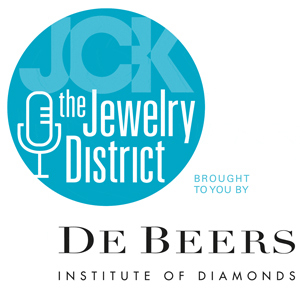
While De Beers—and the jewelry industry as a whole—have enjoyed a strong first half of 2022, the company feels a lot more cautious about the second half, CEO Bruce Cleaver (pictured) told JCK in an interview Friday, a day after the release of De Beers’ first-half financial results.
“I’m surprised and impressed at how robust American demand has been,” Cleaver says. “But there’s no question things are getting a bit slower. I am sure there will be many twists in the next six months. My message is to my organization is we are going to have to be really focused on costs and productivity.”
He notes that, with travel returning, “there will be more competition in the second half than we had in the first.”
Still, given the industry’s coming off a historic 18-month run, he urges the trade to remember “there’s a lot to be positive about.”
“Now is the time to invest more in marketing,” he says. “We have to keep doing more to capture new consumers.”
De Beers has raised prices on rough recently, leading some sightholders to complain about tightening margins.
“We try very hard to price rough to meet the resultant polished,” he says. “There’s no doubt that polished prices have risen in the first half. We will continue to be responsible. We want to ensure that sightholders make a decent return.”
He believes that sanctions on Russian diamonds have led to “an illusion of scarcity,” particularly in the United States.
Russia’s invasion of Ukraine has also boosted De Beers’ origin program, Tracr, he says.
“In 2022, we put Tracr on steroids. Provenance is never going away as an issue, and it always was an issue.”
Having Tracr-verified provenance is now an option for sightholders, and more than half of them currently use it, he says.
JCK has heard two objections to the program. First, De Beers clients—as well as people who buy from those clients—don’t necessarily want their downstream customers to know which companies they source goods from, because those customers can just go around them and buy direct from those companies.
“We have privacy settings that let you hide that data,” Cleaver says. “You will be able to see that the diamond changed hands,” but users can decide whether the names of the companies that sold it will be visible.
Others have worried that non-Tracr goods could end up devalued.
“There are some things that we do need to think about, but I don’t think that’s a reason not to do this. That’s what people said before the Kimberley Process launched. That’s an issue whenever you have greater transparency. But this is the direction the world is moving.”
Currently, the program is available for rough stones of 1 carat and above. Tracing smaller stones is “another challenge,” he says.
De Beers recently signed an extension of its contract with Botswana. The country’s president, Mokgweetsi Masisi, has reportedly suggested that HB Antwerp’s deal with Lucara—where the diamonds are bought on credit and the miners receive part of the eventual proceeds—could serve as a model.
“We have done a tremendous amount to help beneficiation in Botswana,” he says. “There are now 32 diamond-cutting factories in Botswana. A few years ago, there were six. That has been a significant development in getting as many goods as possible manufactured in Botswana. The government is very happy with that.
“We are very comfortable with our distribution. They are comfortable with it too. I think we are much more aligned than some people might think.”
As far as the De Beers Forevermark brand’s plan to take over wholesale distribution of loose goods—which has proven unpopular with retailers and sightholders—Cleaver indicated that it isn’t set in stone.
“We are piloting different alternatives. We will have a look at what works, and look to get feedback from our customer base.”
Regarding lab-grown diamonds, “It’s been an interesting year and half. There has been tremendous growth in both natural and lab-grown. There’s increasing evidence that not all lab-growns are cannibalizing natural purchases, especially as the price differential grows larger. The trends are broadly where we thought they would be. There’s a lot more lab-grown production, and in my view, the more production we see, the more prices will start to come down.”
Cleaver says he hasn’t seen the Showtime documentary Nothing Lasts Forever, set to debut this fall, but he says De Beers will look to correct any “inaccuracies.”
Photo courtesy of De Beers
Follow JCK on Instagram: @jckmagazineFollow JCK on Twitter: @jckmagazine
Follow JCK on Facebook: @jckmagazine





